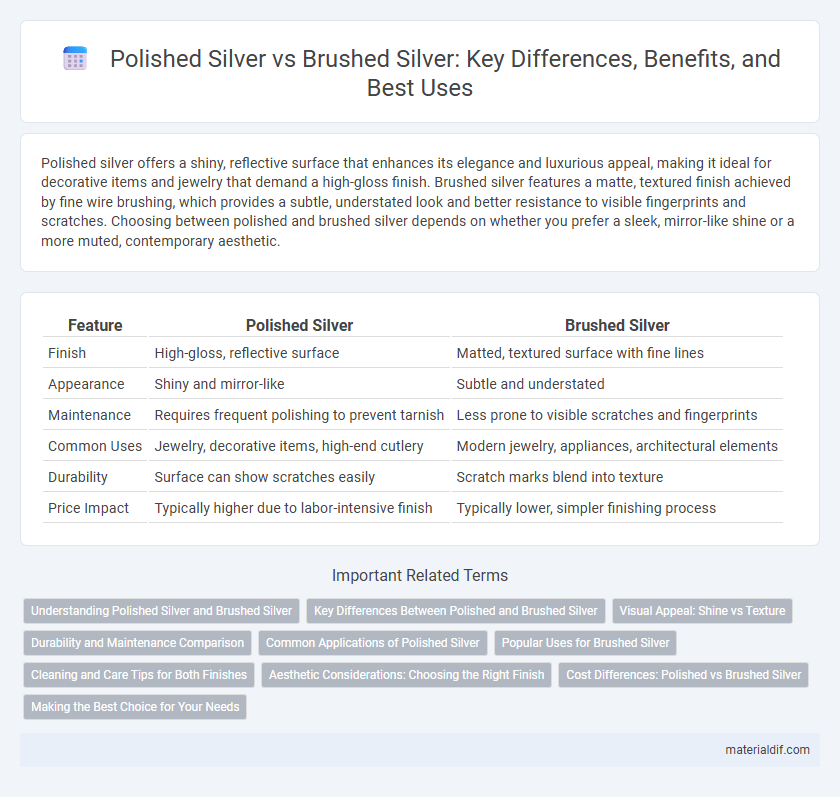Polished silver offers a shiny, reflective surface that enhances its elegance and luxurious appeal, making it ideal for decorative items and jewelry that demand a high-gloss finish. Brushed silver features a matte, textured finish achieved by fine wire brushing, which provides a subtle, understated look and better resistance to visible fingerprints and scratches. Choosing between polished and brushed silver depends on whether you prefer a sleek, mirror-like shine or a more muted, contemporary aesthetic.
Table of Comparison
| Feature | Polished Silver | Brushed Silver |
|---|---|---|
| Finish | High-gloss, reflective surface | Matted, textured surface with fine lines |
| Appearance | Shiny and mirror-like | Subtle and understated |
| Maintenance | Requires frequent polishing to prevent tarnish | Less prone to visible scratches and fingerprints |
| Common Uses | Jewelry, decorative items, high-end cutlery | Modern jewelry, appliances, architectural elements |
| Durability | Surface can show scratches easily | Scratch marks blend into texture |
| Price Impact | Typically higher due to labor-intensive finish | Typically lower, simpler finishing process |
Understanding Polished Silver and Brushed Silver
Polished silver features a smooth, reflective surface achieved through meticulous buffing that enhances its shine and highlights intricate details. Brushed silver displays a matte finish created by fine, directional strokes that reduce glare and provide a modern, textured appearance. Understanding these finishes helps in selecting silverware or jewelry based on desired aesthetics and maintenance preferences.
Key Differences Between Polished and Brushed Silver
Polished silver features a highly reflective, mirror-like surface achieved through buffing and polishing processes, emphasizing its shiny and smooth appearance. Brushed silver, on the other hand, displays a matte finish with fine parallel lines created by a brushing technique, offering a more subdued and textured look. The key differences lie in the surface texture and light reflection, with polished silver being more prone to visible scratches, while brushed silver better conceals wear and fingerprints.
Visual Appeal: Shine vs Texture
Polished silver exhibits a highly reflective, mirror-like shine that enhances its elegance and highlights intricate details, making it ideal for decorative accents and jewelry. Brushed silver, characterized by its matte finish and fine linear texture, offers a subtle, sophisticated look that reduces glare and conceals fingerprints. The choice between polished and brushed silver ultimately depends on the desired visual appeal: vibrant brilliance versus understated texture.
Durability and Maintenance Comparison
Polished silver features a smooth, reflective surface that tends to show scratches and tarnish more easily, requiring frequent cleaning and careful handling to maintain its shine. Brushed silver has a textured matte finish that conceals minor scratches and fingerprints, offering greater resistance to everyday wear and less intensive maintenance. In terms of durability, brushed silver is more practical for high-use items due to its ability to retain appearance with minimal upkeep compared to polished silver.
Common Applications of Polished Silver
Polished silver is commonly used in jewelry, cutlery, and decorative household items due to its highly reflective surface that enhances aesthetic appeal. It is preferred in luxury settings like formal dining and high-end accessories where a shiny, mirror-like finish is desired. Its smooth, glossy texture also makes it ideal for trophies, awards, and ornamental pieces that require a sophisticated, elegant look.
Popular Uses for Brushed Silver
Brushed silver is widely favored in contemporary interior design for its matte finish that minimizes fingerprints and smudges, making it ideal for kitchen appliances, cabinet handles, and bathroom fixtures. Its subtle texture enhances modern and industrial aesthetics without the high shine of polished silver, providing durability and a sophisticated look. Commonly used in jewelry as well, brushed silver offers a low-maintenance alternative that appeals to those seeking understated elegance with a resistant surface.
Cleaning and Care Tips for Both Finishes
Polished silver requires regular gentle cleaning with a soft cloth to prevent tarnish buildup, using specialized silver polish for stubborn spots while avoiding abrasive materials that can scratch its glossy surface. Brushed silver benefits from cleaning with mild soap and water or a silver-specific cleaner applied with a soft brush to maintain its matte texture without dulling the finish. Both finishes should be stored in anti-tarnish bags or cloths and kept away from humidity and direct sunlight to preserve their distinctive appearance longer.
Aesthetic Considerations: Choosing the Right Finish
Polished silver offers a bright, reflective surface that enhances elegance and luxury, ideal for formal settings and jewelry that demands high shine. Brushed silver features a matte, textured finish that conceals fingerprints and scratches, making it a practical choice for everyday items and modern design aesthetics. Selecting between polished and brushed silver depends on the desired visual impact and maintenance preferences, balancing sophistication with durability.
Cost Differences: Polished vs Brushed Silver
Polished silver typically costs more than brushed silver due to the labor-intensive process required to achieve its high-gloss, mirror-like finish. The brushing technique involves less polishing and equipment time, resulting in lower production costs and a more matte, textured appearance. Market prices for polished silver items often reflect the premium for enhanced shine and aesthetic appeal compared to the understated, modern look of brushed silver.
Making the Best Choice for Your Needs
Polished silver offers a highly reflective surface that enhances elegance and is ideal for formal settings or decorative pieces, while brushed silver provides a muted, matte finish that hides scratches better and suits modern, casual environments. Consider the desired aesthetic and maintenance level; polished silver requires regular cleaning to maintain its shine, whereas brushed silver is more forgiving with wear and easier to maintain. Choosing between polished and brushed silver depends on whether you prioritize a glossy look or practical durability for everyday use.
Polished Silver vs Brushed Silver Infographic

 materialdif.com
materialdif.com